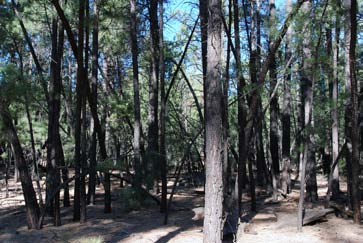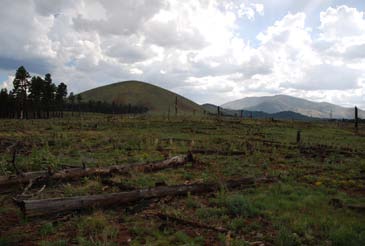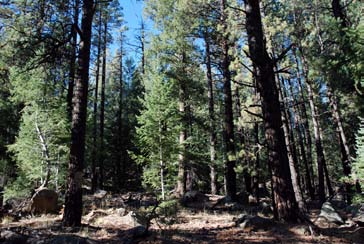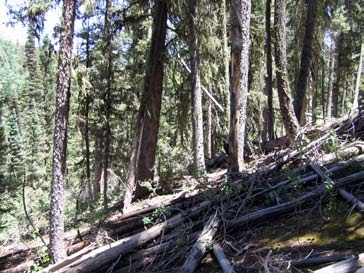Prior to settlement by non-indigenous peoples, Native American impacts on southwestern montane forests were highly localized. Initial impacts of non-indigenous peoples on montane forests were also small, but grew in the second half of the 19th century when railroads linked the American Southwest to large commercial markets and made livestock grazing and timber harvesting profitable.
Before Settlement by Non-indigenous Peoples
Prior to settlement by non-indigenous peoples, Native American impacts such as burning and cutting of southwestern montane forests were highly localized (Allen 2002) and generally focused on ponderosa pine forest. Clearing for agriculture occurred mostly in pinyon-juniper vegetation at lower elevations.
After Settlement by Non-indigenous Peoples
Initial impacts of non-indigenous peoples on montane forests were also small, but grew in the second half of the 19th century when railroads linked the American Southwest to large commercial markets and made livestock grazing and timber harvesting profitable.
Livestock grazing
The major impact of 19th-century grazing of domestic sheep and cattle on the montane forests of the Southwest remained little recognized until ecological research in the second half of the 20th-century linked it to the end of surface fires. In brief, the livestock grazed understory grasses and forbs, which reduced the contiguity of surface fuels in forests. This prevented the spread of surface fires, abruptly altering fire regimes. Without the thinning effects of frequent surface fires, more seedlings, saplings, and trees survived, and montane forests dramatically increased in density.
Timber harvesting
Logging was another historical factor that greatly affected the structure of montane forests. Following extensive clearcutting in the late 19th and 20th centuries (primarily in ponderosa pine forest), regeneration resulted in dense stands of tree seedlings. Without the thinning effects of frequent surface fires, these stands matured into much denser, more even-aged forests than had been present before logging.
Fire suppression
Fires initially were unintentionally excluded from montane forests of the American Southwest by livestock grazing, but soon after the turn of the 20th century land management agencies such as the newly created U.S. Forest Service began to intentionally put out fires in an attempt to protect forest resources. Fire suppression became a focus of management practices in the Forest Service and later in other agencies like the National Park Service, and it was increasingly effective in stopping fires through most of the 20th century. With the exclusion of fire, the structure and species composition of southwestern forests dramatically changed, as did their fire regimes.
Management fire
As the adverse effects of excluding fires became widely recognized in the second half of the 20th century, forest management practices changed to include reintroducing fire. Initially this was done through prescribed burning, i.e., fires set under prescribed conditions of temperature, humidity, wind speed, fuel moisture, etc. The intent was to ensure that prescribed burns remain surface fires, be restricted in area, and accomplish specific goals such as reduced tree densities and fuels (e.g., dead trees and forest floor litter such as needles and downed branches). Research findings on historical forest conditions were used as a reference point for management. Later, selected lightning-ignited fires began to be used for similar purposes. Fires were first reintroduced into ponderosa pine forest because of the relatively low risk of surface fires becoming crown fires. Reintroduction into mixed conifer forest has proven more challenging because of greater risk of undesirably large crown fires.
Exotic invasive plants
Exotic plants can alter ecosystem structure, composition, and function and can be a threat to biodiversity. Invasives generally are not as abundant in the Southwest as in other regions of the United States, primarily because extensive, intensive land use began later in this region (Rejmánek and Randall 1994); however, invasives are of growing concern in the region. The abundance of invasives in montane forests is highly variable. In general, they increase with disturbance (e.g., Laughlin et al. 2004, Crawford 2008) and decrease with increasing elevation (Vankat 2005).
Recent climate change
Climate has always changed, but this paragraph deals with recent climate change induced by human actions. Effects on montane forests of the Southwest have not been well-studied. Nevertheless, there are strong indications of links between recent climate change and forest changes. For example, climate change is likely involved in increased insect-caused tree mortality, an effect well-documented for pinyon pine in pinyon-juniper vegetation (Breshears et al. 2005) and apparently also present in montane forests (e.g., Worrall et al. 2008; cf. Vankat 2011b). Also, recent climate change has been linked to increased large wildfire activity in the western U.S. (Westerling et al. 2006).
Air pollution
Air pollution is a cause of recent climate change, but air pollutants can have direct effects on forest trees as well. Such effects have been little studied in the Southwest; however, the current atmospheric levels of ozone in some areas of the Southwest exceed the levels that have affected trees in montane forests of other regions (Vankat 2005).
Fragmentation
Fragmentation is a natural factor for montane forests of the Southwest because of their distribution on plateaus and mountains separated by lowlands. However, human-caused fragmentation occurs with clear-cut logging and increased landscape-scale crown fires. Such fragmentation has not been studied, although it may affect species’ abilities to migrate to favorable areas in response to climate change.
Effects on Montane Forests

Photo by Betty Huffman
Ponderosa pine forest
Ponderosa pine forest has been more impacted than other montane forests of the American Southwest. Nearly all of it was grazed by livestock (much is grazed today), logged (some continues today), altered by fire exclusion, affected by recent climate change, and invaded by exotic plants.
As the result of fire exclusion and past logging, forest stands are much denser today than before settlement by non-indigenous peoples (right). Mid and high elevation stands also have shifted in species composition as a result of fire exclusion, with large increases in white fir, which is fire-intolerant and shade-tolerant, and decreases in aspen, which regenerates primarily by fire-stimulated root sprouting. In addition, forest fuels accumulated over the century without fire and have been augmented by widespread tree mortality caused by barkbeetle outbreaks, which in turn are related to recent climate change. With increased density and fuels, stands of ponderosa pine forest have become much more susceptible to crown fire, in effect shifting the fire regime from surface fire to mixed-severity fire. Where crown fire or clear-cut logging have occurred, succession has changed in scale from single trees to stands or landscapes. In some lower-elevation areas, forest has been replaced by semi-permanent pinyon-juniper vegetation.

Photo by Betty Huffman
In other areas, forest has been replaced by grasslands (right) or shrublands (Savage and Mast 2005). Fire regimes have the potential to be affected by cheatgrass (Bromus tectorum), an exotic invasive annual whose yearly production of biomass may literally fuel an unnaturally high frequency of surface fires.
In some areas, forest managers used mechanical thinning of small trees and management fires to address the increases in forest density and fuels and changes in forest composition. Nevertheless, much of the ponderosa pine forest needs restoration.

Photo by Betty Huffman
Mixed conifer forest
Nearly all of the mixed conifer forest was grazed by livestock (some continues today), altered by fire exclusion, and apparently affected by recent climate change. In comparison to ponderosa pine forest, there has been little logging, primarily because many stands are inaccessible and have few ponderosa pines, the most valuable timber species of the American Southwest. Exotic invasive plants are uncommon except in early stages of succession following crown fire (cf. Crawford 2008).
As a result of fire exclusion, mixed conifer forest increased in density, at least until the mid-20th century (Vankat 2011b), as well as in fuels (above). Species composition also changed, with increases in shade-tolerant, fire-intolerant species such as white fir and subalpine or corkbark fir. With increased density and fuels, the mixed-severity fire regime changed to include more crown fire, and today it may be a crown fire regime.
For example, the mixed conifer forest of the topographically diverse North Rim region of Grand Canyon National Park in northern Arizona formerly had only small patches of crown fire (Fulé et al. 2003a,b), but experienced landscape-scale crown fires in the first decade of the 21st century. Post-fire succession in these areas produced extensive stands of quaking aspen forest. These had not been present historically but now have the potential to become semi-permanent where long distances to seed sources limit ingrowth of conifers. In addition, even unburned stands of mixed conifer forest of this area have changed. Recent research indicated tree density peaked in the mid-20th century and decreased to the early 21st century. Large decreases in aspen accounted for much of this decrease in tree density because of several factors including lack of surface fires, and the decreases in conifers appear to be related to unsustainably high tree density and recent climate change (Vankat 2011b).
Historical increases in forest density and fuels and changes in species composition have been addressed by forest managers in a few areas with mechanical thinning of small trees and with management fires. Thinning is difficult because of poor accessibility, and the use of management fires risks surface fires becoming crown fires. Most of the mixed conifer forest needs restoration.

Photo by John Vankat
Spruce-fir forest
Spruce-fir forest has been less impacted by human-caused stressors than either ponderosa pine forest or mixed conifer forest. There has been little logging (because of poor accessibility) or invasion by exotic plants. Livestock grazing (some continues today) and fire exclusion affected lower elevation stands, but their impacts on higher elevation stands are unclear. Recent climate change appears to have affected all elevations.
Changes in stand structure, species composition, and fire regime in low elevation spruce-fir forest have been similar to those described above for mixed conifer forest. In northern Arizona’s Grand Canyon National Park, tree density appears to have increased with fire exclusion to the mid-20th century and then decreased (above). Large decreases in aspen were caused by several factors including lack of surface fires, and decreases in conifers were likely related to unsustainably high tree density and recent climate change (Vankat 2011b). In addition, the fire regime may have shifted to more crown fire, at least until canopies of some stands began to open after the mid-20th century. Forest managers have addressed increases in forest density in a few lower elevation stands by mechanically thinning small trees; however, this is difficult in many areas because of poor accessibility. Use of management fires is also challenging because of the risk of surface fires becoming crown fires.
Changes in upper elevation stands are less well known. Fire exclusion, which has lasted a little more than a century, may not have affected these forests because historically, crown fires likely occurred at intervals of one or more centuries. In some high-elevation areas, the spruce and fir canopy has died as a result of insect outbreaks that are likely tied to recent climate change.
Quaking aspen forest
Quaking aspen forest has also had relatively few impacts. Livestock grazing occurred (some continues today), and fire exclusion and climate change may have reduced the health of stands. However, there has been little logging or invasion by exotic plants.
The effects of fire exclusion on quaking aspen forest are complex. As described above, landscape-scale crown fires following fire exclusion in mixed conifer forest have resulted in the establishment of large areas of quaking aspen forest. However, fire exclusion (by reducing aspen sprouting and mortality of conifers) may expedite the successional conversion of quaking aspen forest into mixed conifer forest. Fire exclusion is also one of many factors involved in the declining health of stands in many areas of the Southwest. Aspen is not regenerating well due to fire exclusion and grazing of sprouts by livestock and elk. “Sudden aspen decline,” which refers to mortality caused by insects, bark beetles, and canker fungi in response to drought, high temperatures, late frosts, and repeated defoliation by insects, is also affecting stand health (Worrall et al. 2008). The role of climate in affecting insects, bark beetles, and canker fungi suggests sudden aspen decline is related to recent climate change.
Forest managers have attempted restoration of quaking aspen forest on a limited scale. Approaches include prescribed burning and fencing to exclude livestock and elk. Prescribed fires pose a risk of crown fire in adjacent mixed conifer stands, and fencing is costly.
Part of a series of articles titled Montane Forests of the Southwest.
Last updated: October 5, 2016
